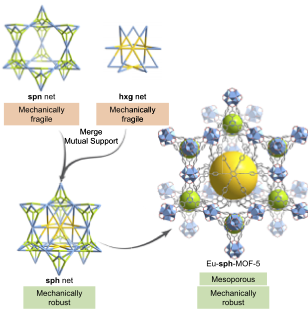H. Jiang, S. M. Moosavi, J. Czaban-Jóźwiak, B. Torre, A. Shkurenko, Z. O. Ameur, J. Jia, N. Alsadun, O. Shekhah, E. Di Fabrizio, B. Smit, and M. Eddaoudi, Reticular chemistry for the rational design of mechanically robust mesoporous merged-net metal-organic frameworks Matter-Us (2022) doi: 10.1016/j.matt.2022.10.004

Abstract: Access to metal-organic frameworks (MOFs) with enhanced mechanical stability is key to their successful deployment in practical applications. However, the high porosity of the material often affects mechanical stability. In this article, to achieve highly porous MOFs with enhanced mechanical stability, we explored the merged-net approach where two relatively fragile frameworks were merged into a robust MOF structure. We demonstrate the effectiveness of this approach by computationally evaluating mechanical properties of sph-MOFs with varying lengths of linkers. Prominently, we pinpoint the significance of triangular rigidity on the robustness of large-pore MOFs and, subsequently, designed and synthesized a rare earth (RE)-based RE-sph-MOF-5 by the reticulation of hexanuclear RE clusters, tritopic linkers, and unprecedentedly large planar hexatopic linkers containing 19 phenyl rings. The mechanical properties of sph-MOFs were characterized and quantified using amplitude-frequency modulation (AM-FM) bimodal atomic force microscopy (AFM) analyses. Markedly, the mesoporous RE-sph-MOF-5 expresses high mechanical stability despite its large mesoporous cavities.